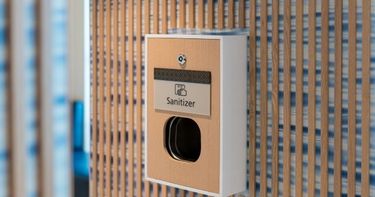
Food businesses have been on the front line with a raft of measures and preventative actions to stop COVID-19 from spreading. Although well accustomed to maintaining a high standard of cleanliness, food businesses not only need to pay more attention to the hygiene of staff, but they also need to encourage customers to do the right thing.
Hand hygiene, in particular, is a huge focus of food establishments. Whether it be supermarkets, pubs, cafés, or food manufacturers, installing highly visible sanitiser stations is one way to encourage everyone to do the right thing. But how do you go about choosing the safest and most effective station?
Here are three things that you should consider when choosing a hand sanitiser station for your business.
1. Alcohol content
It’s important to note that all sanitiser products should contain antiseptic ingredients that kill or prevent the growth of microorganisms. Ideally, purchase a hand sanitiser that is clearly labelled and meets standards set by a respected body such as the World Health Organisation (WHO). The public health agency recommends consumers adhere to a minimum alcohol content of 80% ethanol or 75% isopropyl alcohol.
If WHO certification is not achievable, look for products regulated by the Therapeutic Goods Association (TGA) in Australia. Regardless of certification, avoid any hand sanitiser with less than 60% ethanol or 70% isopropanol because it simply won’t be effective.
2. Station features
When choosing a hand sanitiser station, some features are down to individual choice. One such example is the preference for an automatic, touch-free, manual, or foot-operated sanitiser dispenser.
Some other features are more essential. The stands need to be sturdy and lockable, depending on location. It is also important that stations are adaptable so that children and those in wheelchairs can easily access them. Customisable signage with clear instructions for use is similarly crucial.
3. Visible locations
While many businesses will use a hand sanitiser station at entrances, don’t neglect other high-risk areas. These include bathrooms, food preparation areas, transaction counters, and employee break rooms.
Visibility in these areas is vital because it increases the chances that employees and customers alike will use the stations. Indeed, research published in the Archives of Internal Medicine found that compliance with safe hygiene practices increased with high ease of access to hand sanitiser stations.
With COVID-19 continuing to wreak havoc across the globe, hand sanitiser stations are essential. Given the increasing longevity of the virus, it is important to select a hand sanitiser station that meets certain standards while offering the right mix of features and ease of access.
Article posted by: Food Safety Select
As a food business owner, you understand the impor...
View MoreFoodborne illness is a significant concern for Aus...
View MoreThe food industry is no stranger to the threat of ...
View MoreAs a food business owner, it's crucial to ensu...
View More_1.png)